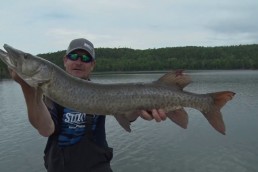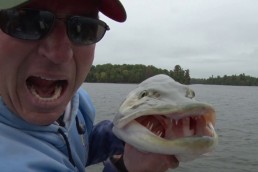A Hunting Primer for Lever-action Bushy Tails
SHARE THIS POST
There’s something about squirrel hunting that brings it all back to earth. Growing up hunting the hills, hollers and hardwood ridges, scanning the branches for a glimpse of the twitch of a tail, or listening for the telltale sounds of nut pieces raining down from high atop an old shag bark hickory. The beginnings of a good hunter often involved chasing bushy tails as a youngster, and honing those senses so vital for hunting other game.
Those squirrel hunts back in Lynchburg, Tennessee as a young boy remain forever stamped in my mind, like little video clips occasionally called up for reference, or just to remember the good times. Those days were spent cradling my first gun, a 16-gauge, single-shot Winchester, in the crook of my arm, or broke over my shoulder.
As a kid, the excitement seems to be almost overwhelming, and is still there—maybe slightly diminished in comparison. To reach that level of excitement again, you would have to journey back in time, cradling that same shotgun, and walk those same ridges where your name still lives, carved in a giant beech tree. Your favorite spot to watch the sun rise, and smell the sour mash drifting from the distillery just down the way.
Recently, I was able to regain a little of that childhood excitement, hunting squirrels with my new Henry lever-action .410 shotgun. A lever-action has always been a favorite, and to have one chambered for the .410 shotgun round was exciting enough.
The perfect close-range, get-in-close squirrel gun was born with the Henry lever-action .410, and with its 24-inch model, you get a threaded barrel for interchangeable chokes. While the range of the .410, with its 2.5-inch chamber, ain’t going to knock your socks off, it will knock a squirrel off a limb, and bust through some foliage to get there.
The Henry .410 lever-action is best used when the leaves are still on the trees. With our spring squirrel season here in Kentucky, much of the hunting we do for squirrels is with the leaves intact. These leaves can make it tricky to locate squirrels high in the tree-tops, but it can also help you get in close, using the foliage as cover as you slowly make your way into range. It is this close-range hunting that rekindled my excitement for hunting squirrels again.
There are many tactics for hunting squirrels, and getting close enough for a shotgun. My favorite is to just still hunt and listen. Squirrels will give themselves away if you show a little patience. You can hear squirrels as they scamper up and down a tree. You can hear them gnawing on the various mast during the fall, giving their position away. Use some good binoculars to scan the treetops for the sound. Look for a flick of a tail, or a sudden movement as the bushy tail hurries to get another nut, or reacts to a hawk flying nearby. Once spotted, slowly stalk your way into range. With the .410 lever-action, you will need a few extra steps to get into range. This makes it all the more fun to hunt with.
With interchangeable chokes, you can adjust your pattern to the situation. Briley Chokes, out of Houston, Texas, makes a great set of chokes that fit the Henry .410 lever gun. Briley chokes can be flush, or extend from the barrel. The extended chokes are fluted, knurled and slotted for easy replacement in the field. I have started carrying a set of Briley chokes in the field with me, so I can change the choke to match the situation.
Are you enjoying this post?
You can be among the first to get the latest info on where to go, what to use and how to use it!
Extra full is the choke I prefer to hunt bushy tails. However, a full or even a modified choke might be a better choice. Sometimes, the squirrels you are hunting are real skittish. This skittishness can come from being pressured by other hunters, or by many of the other predators that prey on the squirrel. When squirrels are like this, they tend to tolerate less intrusion in their area, and notice it much more quickly.
When this happens, they don’t stick around chattering on a limb while you get in position. Instead, they take off at the slightest movement, and don’t look back. When this happens, a less-than-full-choke can become your best friend in the squirrel woods, as you attempt to put a good shot on a running, leaping, scampering squirrel getting out of Dodge.
My next favorite way to hunt squirrels is by calling. Calling can and is used during still-hunting squirrels. Sometimes, it’s the only way to get a squirrel to move enough for a glimpse and a shot. Calling squirrels is an age-old trick. Many techniques were created over the years. With the technology that has taken over the call industry, a good bellows call is the best way to go.
A bellows call lets you call with one hand, while you scan the treetops for movement with binoculars in the other. You can mimic a distress call, barking and chatter. Each call has its place, and with practice can become a great way to get in close with the lever-action, and fill your limit. You can locate squirrels with the call by listening for a response, then begin your stalk. I keep the call in my pocket if I can, because while the call can help you locate squirrels, it also helps the squirrels locate you.
Make sure you are well hidden when you make the call, because the squirrels will be searching the area for the squirrel that made the call. Wait until the squirrels stop responding before making your move, or you could get busted without even knowing it.
I haven’t shot all of the available ammunition for the Henry lever-action .410, but I have sampled a few. The best ammo I have found so far is the Remington Express Extra Long Distance shells in 4 or 6 shot. I carry both the 4 and the 6 shot to the woods, and use the size that is best that day. The 4 shot has less pellets. It works best when the squirrels are sitting still and are not skittish. However, when the bushy tails are alert and not tolerating much before bolting through the trees, I like to use the 6 shot to give me a little more spread, and a better chance of adding another to the bag.
Squirrel hunting has taken a back seat recently to so many other outdoor quests. Instead of starting kids out chasing these woodland game animals that offer good numbers, just the right challenge and delicious table fare, we expect a young hunter to arrow a 140-class whitetail or slam a sage old gobbler.
It is time to give credit where credit is due, remember our childhood, and what it meant to chase these critters with a shotgun down a fencerow, or in the hardwoods with little-to-no worries. Try grabbing the Henry .410 lever-action, and stalk your way up an old dry creek bed, or sit motionless near a big hickory tree, and see if those memories come flooding back like they did for me. Those wonderful days, long ago, smelling sour mash and watching the sunrise next to that old beech tree, where my name still lives.
MWO
SHARE THIS POST
Did you enjoy this post?
You can be among the first to get the latest info on where to go, what to use and how to use it!



